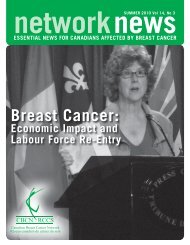Report Card on Wait Times in Canada
Report Card on Wait Times in Canada
Report Card on Wait Times in Canada
Create successful ePaper yourself
Turn your PDF publications into a flip-book with our unique Google optimized e-Paper software.
A <str<strong>on</strong>g>Report</str<strong>on</strong>g> <str<strong>on</strong>g>Card</str<strong>on</strong>g> <strong>on</strong> <strong>Wait</strong> <strong>Times</strong> <strong>in</strong> <strong>Canada</strong> 2012<br />
1. Grad<strong>in</strong>g Canadians’ timely access to care<br />
For the first time, the WTA has expanded its traditi<strong>on</strong>al<br />
Table 1 to grade timely access for both procedures for which<br />
pan-Canadian government benchmarks exist (i.e., hip and<br />
knee replacement, cataract surgery, radiati<strong>on</strong> therapy, heart<br />
bypass surgery) as well as for a range of other procedures<br />
chosen by WTA member specialties us<strong>in</strong>g WTA benchmarks.<br />
The letter grades perta<strong>in</strong> to how well prov<strong>in</strong>ces are<br />
do<strong>in</strong>g <strong>in</strong> terms of the percentage of patients receiv<strong>in</strong>g treatment<br />
with<strong>in</strong> the benchmark (e.g., A=80% or more patients<br />
treated with<strong>in</strong> the benchmark). The colour grades <strong>in</strong>dicate<br />
whether the percentage of patients treated with<strong>in</strong> the<br />
benchmark has <strong>in</strong>creased from spr<strong>in</strong>g 2011 to 2012<br />
(green), has significantly decreased (red) or stayed about<br />
the same (yellow).<br />
A. Grad<strong>in</strong>g performance us<strong>in</strong>g the governments’ pan-<br />
Canadian benchmarks<br />
For several years, the WTA report cards have reported slight<br />
progress <strong>in</strong> improv<strong>in</strong>g Canadians’ timely access to a narrow<br />
range of procedures: cancer (radiati<strong>on</strong> therapy); heart (bypass<br />
surgery); jo<strong>in</strong>t replacement (hip and knee); sight restorati<strong>on</strong><br />
(cataract) and diagnostic imag<strong>in</strong>g (CT and MRI). However,<br />
<strong>in</strong> 2012, this claim of “slight progress” can no l<strong>on</strong>ger be made<br />
(see top porti<strong>on</strong> of Table 1):<br />
• There is no improvement <strong>in</strong> the overall nati<strong>on</strong>al grades<br />
between 2011 and 2012, and <strong>in</strong> some prov<strong>in</strong>ces grades<br />
have fallen. For example, there are two F grades us<strong>in</strong>g the<br />
government benchmarks <strong>in</strong> the 2012 report card, compared<br />
to <strong>on</strong>e <strong>in</strong> 2011.<br />
• In several <strong>in</strong>stances, the percentage of patients treated<br />
with<strong>in</strong> the benchmark has decreased <strong>in</strong> 2012 compared<br />
to 2011. This can be seen with the <strong>in</strong>crease <strong>in</strong> the number<br />
of red squares (i.e., 9 <strong>in</strong> 2012 compared to <strong>on</strong>ly 2 <strong>in</strong><br />
2011). In additi<strong>on</strong>, the 2012 report card features <strong>on</strong>ly<br />
13 <strong>in</strong>stances of improvement (i.e., a green square or 5%<br />
or greater <strong>in</strong>crease <strong>in</strong> patients treated with<strong>in</strong> the benchmark)<br />
compared to 24 <strong>in</strong> 2011.<br />
The pursuit of more timely access to care is a journey<br />
that will see its share of setbacks. However, the WTA is c<strong>on</strong>cerned<br />
with the backslid<strong>in</strong>g seen <strong>in</strong> most prov<strong>in</strong>ces. This<br />
year’s assessment clearly dem<strong>on</strong>strates the need to c<strong>on</strong>t<strong>in</strong>ue<br />
efforts to improve Canadians’ access to timely care.<br />
B. Grad<strong>in</strong>g a wider range of procedures/treatments<br />
us<strong>in</strong>g WTA benchmarks<br />
S<strong>in</strong>ce 2007, the WTA has called <strong>on</strong> governments to endorse<br />
nati<strong>on</strong>al wait-time benchmarks/targets for health services<br />
bey<strong>on</strong>d the <strong>in</strong>itial five areas. In fact, the 2004 Health<br />
Accord stated governments were to “start” with the <strong>in</strong>itial<br />
five areas – not to beg<strong>in</strong> and end with them. Recogniz<strong>in</strong>g<br />
the importance of reduc<strong>in</strong>g waits for all patients, the WTA’s<br />
13 nati<strong>on</strong>al specialty society members have established waittime<br />
benchmarks for 925 treatments, procedures or<br />
diagnoses.*<br />
Table 1 also lists over 45 medical treatments/c<strong>on</strong>diti<strong>on</strong>s<br />
that have either the highest volumes, the greatest potential<br />
for improvement or the greatest return-<strong>on</strong>-<strong>in</strong>vestment,<br />
based <strong>on</strong> WTA member <strong>in</strong>put. <strong>Wait</strong>s were graded based <strong>on</strong><br />
<strong>in</strong>formati<strong>on</strong> publicly available <strong>on</strong> prov<strong>in</strong>cial websites. A<br />
questi<strong>on</strong> mark (?) is assigned if the prov<strong>in</strong>ce does not report<br />
wait times for the particular treatment/service. An eyeglasses<br />
symbol ($) <strong>in</strong>dicates that the prov<strong>in</strong>ce tracks wait<br />
times for this specialty but not for the specific procedure <strong>in</strong><br />
a manner that would permit it to be graded by WTA measures.<br />
This <strong>in</strong>cludes grad<strong>in</strong>g cor<strong>on</strong>ary artery bypass<br />
surgery (CABG), radiati<strong>on</strong> therapy and diagnostic imag<strong>in</strong>g<br />
us<strong>in</strong>g WTA benchmarks which are significantly<br />
different than the pan-Canadian government benchmarks.<br />
For example, while all prov<strong>in</strong>ces provid<strong>in</strong>g CABG<br />
received a grade of A us<strong>in</strong>g the government benchmark<br />
(26 weeks), the grades were lower when compared to the<br />
WTA benchmark of six weeks.<br />
There rema<strong>in</strong>s little prov<strong>in</strong>cial report<strong>in</strong>g for most of<br />
the procedures listed <strong>in</strong> this secti<strong>on</strong> of Table 1. Some<br />
report<strong>in</strong>g exists for procedures <strong>in</strong> obstetrics and gynecology<br />
and plastic surgery but there rema<strong>in</strong>s a lack of progress <strong>on</strong><br />
any prov<strong>in</strong>cial report<strong>in</strong>g for such specialties as chr<strong>on</strong>ic pa<strong>in</strong><br />
(anesthesiology), gastroenterology, emergency care (<strong>on</strong>ly<br />
Ontario and Alberta report <strong>on</strong> emergency department wait<br />
times) and psychiatry.<br />
The lack of publicly reported wait-time data for mental<br />
health services was identified <strong>in</strong> the Mental Health Commissi<strong>on</strong><br />
of <strong>Canada</strong>’s recently released Mental Health Strategy for<br />
*<strong>Wait</strong> Time Alliance. <strong>Wait</strong> times benchmarks. Available: www.waittimealliance.ca/wait_times.htm (accessed 2012 June 4).<br />
2














